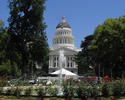It has been clear for years that net domestic migration to and from major metropolitan areas (over 1 million population) has been characterized by moving out of costly areas, like Los Angeles, the San Francisco Bay Area and New York to much less expensive areas, like Dallas-Fort Worth, Houston, Atlanta and Nashville. However, within these metropolitan areas, there are substantial variations. read more »
Demographics
Understanding Major Metropolitan Domestic Migration
- Login to post comments
The California Economy vs. Sacramento
Over the past few years California’s plight has taken on mythic proportions — a cautionary tale of progressive woe among conservatives, but a beacon for a future enlightened capitalism among its woke supporters. The current battle over the potential recall of the preening governor, Gavin Newsom, likely will enhance these extreme interpretations on both sides, but likely will not be sufficient to make the changes needed to restore the state’s legendary promise. read more »
- Login to post comments
A Change Is Gonna Come — Anyway
Frequent readers here may have seen me write about my experience growing up in 1970s Detroit. I’ve often said that seeking ways to improve the city and not abandon it, is what propelled me into a career in urban planning. I wanted to be a change agent for cities. Today, more than thirty years into my career, I’m proud of the stature cities have gained over that time; I’m proud of my contribution to it. However, I feel as if cities have risen in prominence in spite of the efforts of planners, not because of them. read more »
- Login to post comments
Housing Affordability and the Pandemic
The median price of homes in Auckland, New Zealand’s largest city, grew by $100,000 in February, reports the Real Estate Institute of New Zealand. That means prices were growing by $25,000 a week. The good news is that these are New Zealand dollars, which are only worth about 72 cents U.S., which means prices grew by “only” US$18,000 a week. read more »
The Death of the American City
When my grandparents migrated to New York from Russia over a century ago, they found a city that was hardly paradise, but one that provided a pathway towards a better life. Life was tough, crowded and always a paycheck from poverty. My relatives were poor, but so was everyone; eventually, they all bought houses or apartments, and entered the middle class. read more »
- Login to post comments
Battlefield 'Burbs
America’s political culture has been shaped by its rural and urban environments, each of which tends to be dominated by one party. Urban Republicans are now as rare as rural Democrats.
Yet the political future of the country lies in the suburban and exurban rings that dominate every metropolitan region. These voters are made up predominately neither of woke city hipsters nor gun-toting rubes, the stereotypes that dominate our competing cultural memes. The suburbs are the last contestable geography in the country. read more »
Reasons People Are Moving From Los Angeles to Dallas — More Important Than Escaping Higher Taxes
Californians escaping high taxes dominate the real estate news. Yes it is true, leaving California because of high city, county and state income tax for Dallas and Texas, with no income tax, is a motivation, but last on my list of seven reasons why people are moving from Los Angeles to Dallas. People will pay more to live where they like living, whether that means higher taxes, higher home prices or higher cost of living. People will leave a place they do not enjoy if they can afford to. This is the case with Angelenos. Residents have found Los Angeles increasingly unpleasant. read more »
Declining Fertility Rates May Deliver Us to Oblivion
For much of the last half-century we have been living, even cowering, under the threat posed by what Paul Ehrlich in 1968 called the “population bomb.” In Ehrlich’s scenario, widely adopted by the environmental movement and its corporate supporters, ever-increasing numbers would overwhelm the resource base and the food supply and would cause dystopian mayhem across the planet. read more »
- Login to post comments
Why More Americans Should Leave Home and Move to Other States
America has been lazily divided by pundits into red and blue states, as if there weren’t constant movement of people between them. Fortunately, reality is a lot more purple — and hopeful — as immigrants, people of color and millennials reshape parts of America by voting with their feet and moving.
These demographic groups are migrating from the big coastal cities to the suburbs, the interior cities, the South and even parts of the Midwest. And in the process, these newcomers change both their new homes and are also changed by them. read more »
- Login to post comments
Downtown Calgary: At Risk?
Downtown Calgary is a big deal (see photo above and photos following the text). Traditional American and Canadian downtown areas (central business districts or CBDs) are a holdover from the pre-auto era. Their geographical limits were largely set by the early Great Depression, with buildings that were well underway in planning by that time (such as the Chrysler Building and the Empire State Building in New York). CBD’s were far more dominant at that time. read more »






















